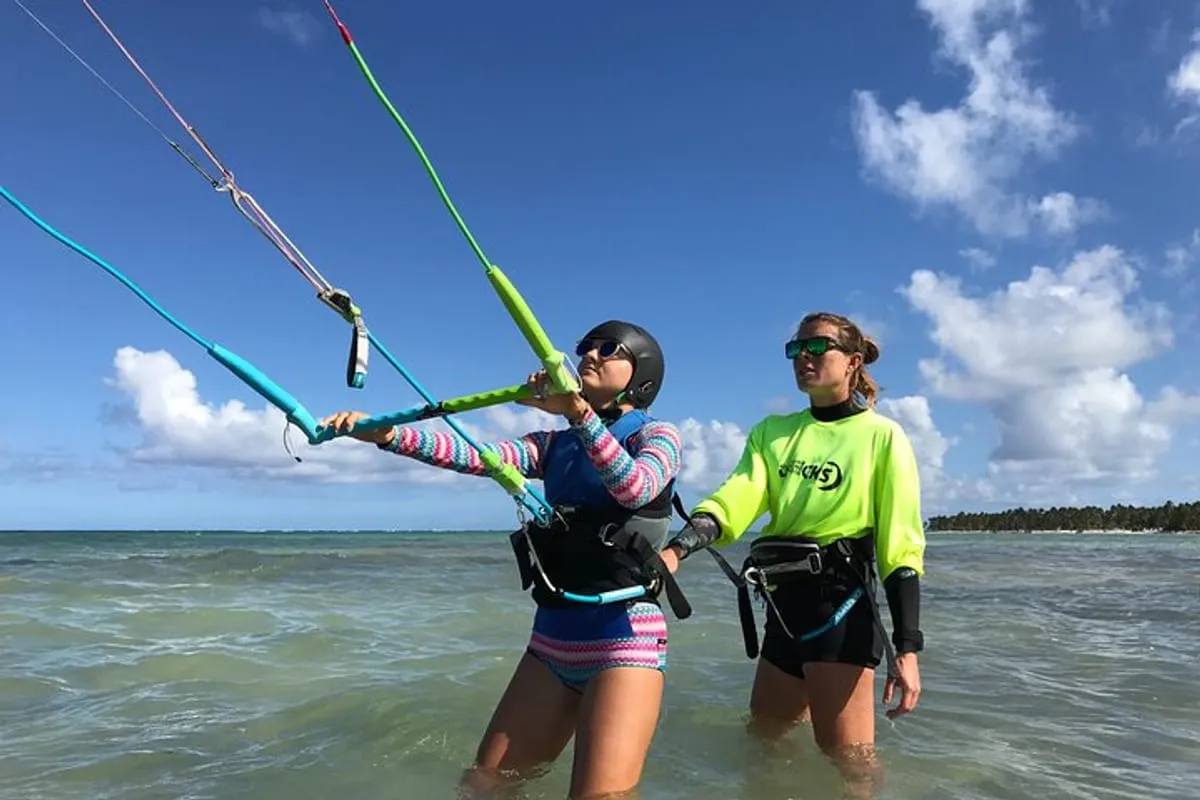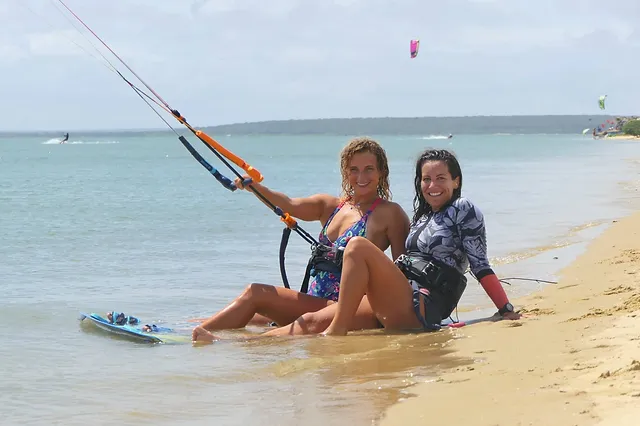Kitesurfing, also known as kiteboarding or kiting, is an action-packed sport that anyone can learn, regardless of age. Contrary to popular belief, you don’t need immense strength or well-trained muscles to enjoy kitesurfing. Kiters use a harness that distributes the power across the entire body, not just the arms. Beginners typically start with a seat harness to help them acclimate, making the sport accessible to everyone. The sensation of the wind propelling you across the water is incredible, and no prior experience is necessary. However, it’s crucial to learn from a reputable and licensed kitesurfing school.
While kites have become much safer over the years, a dedicated kitesurfing holiday offers the best learning experience with quick and safe progression. Learning kitesurfing on holiday is highly recommended because it provides ample time and a relaxed environment. Plus, it’s much more enjoyable at kitespots with consistent wind and warm water, rather than in the cold North Sea. We’ve compiled answers to the most frequently asked questions about learning to kitesurf. Have fun learning to kitesurf!

Kitesurfing, also known as kiteboarding, is one of the coolest water sports you can experience today. The sense of freedom you’ll feel once you ride your first few meters is unparalleled, and with the right kitesurfing course, you’ll find it’s incredibly easy to learn and progress quickly. This diverse sport offers multiple ways to enjoy it: you can cruise on flat water lagoons, perform jumps and tricks, or tackle waves with a surfboard.
Recently, kitefoiling has gained popularity, allowing you to glide above the water’s surface on a hydrofoil. This setup, with a wing and mast beneath the board, reduces resistance and lets you kite in winds as low as 8 knots. Kitesurfing is never dull, and even if you feel a bit overwhelmed after your initial course, you’ll soon discover your unique style and make rapid progress.
What do you need to learn kitesurfing?
Kitesurfing requires much less equipment than windsurfing. The boards are smaller and have no volume, except for wave boards, making them easy to fit into even the smallest car. The kites can be folded into compact backpacks, and you typically won’t need more than two different sizes of kites to start.
It’s recommended not to buy your own equipment before taking a kitesurfing course, as professional kite centers will provide all the necessary gear, adhering to the latest safety standards. In addition to a board and kite, you’ll need a wetsuit, harness, helmet, and buoyancy vest. Depending on the season and location, neoprene shoes might also be required. These essentials will be provided during your kitesurfing course.

Do i need to take professional lessons?
Absolutely!
As a kitesurfing beginner, identifying potential dangers while learning can be challenging or nearly impossible. This includes selecting the appropriate kite for the wind conditions and understanding general weather and location factors. Knowing international hand signals and priority rules is crucial since shouting “out of the way!” at 25 knots won’t be effective.
Enrolling in a professional kitesurfing course not only teaches you to ride the first few meters on the board but also covers essential topics such as safely assembling and dismantling your equipment, conducting spot checks, and understanding all the water rules. Combining your kitesurfing course with a kitesurfing holiday is recommended to ensure you’re relaxed and can focus on your progress.
When choosing a reputable kite school, consider the following points:
- All instructors should be certified, with reliable certificates from organizations like VDWS and IKO, ensuring qualified training.
- The kite school’s equipment should be no older than one season and free from wear, such as worn lines or canvas cracks. The right school will also teach safety topics, including professional assembly and disassembly of equipment, correct take-off and landing with the corresponding hand signals, and spot and weather assessment.
It’s better to book a course lasting longer than three days. Although more expensive than a trial session or three-day course, a five to seven-day course increases the likelihood of being able to water start and ride a few meters by the end. Once you feel confident, you can practice on your own or take an advanced course.
Is Kitesurfing a dangerous sport?
Kitesurfing has become increasingly safe in recent years, and as long as you can swim and have a normal fitness level, there’s nothing stopping you from learning. However, for your safety and that of others, it’s essential to take a professional kitesurfing course. In such a course, you’ll learn how to kitesurf safely and how to avoid endangering yourself and others.

What equiptment do i need to kitesurf
At the beginning, you won’t need your own kite equipment. Choosing among the many different brands, shapes, and designs can be overwhelming, and there’s a high chance you might end up with the wrong gear, making it harder to enjoy learning the sport.
Reputable kitesurfing schools provide the latest learning equipment. If you feel comfortable with the gear after your course, talk to your trainer about which kite and board they recommend. Eventually, you’ll need the following equipment in your kitesurfing journey:
– Kites (at least two different sizes, or preferably more)
– Kiteboard (twintip or wave board, depending on your preference)
– Bars (including lines)
– Harness (starting with a seat harness and later moving to a waist harness)
– Helmet
– Wetsuit (unless you’re heading to warmer destinations like Brazil or Zanzibar)
Learning to fly a kite
Your instructor will start by introducing you to the sport on land, teaching you various safety rules and essential skills before heading into the water. You’ll learn how to assess the wind and evaluate the physical location (the spot), as well as how to properly manage and set up your equipment. You’ll also learn to control the kite in the air. This is an exciting step, as you’ll be flying a real kite for the first time!View the best wave kit info here
What does a kitesurfing lesson look like?
The structure and content of a kitesurfing lesson can vary between schools and instructors. However, if you learn at a school affiliated with a reputable organization like IKO, the curriculum should be standardized. This ensures you can expect the same high level of quality at any IKO Center worldwide.
Let’s explore the typical structure and content of a kitesurfing lesson to give you a better idea of what to expect. This way, you’ll have a reference point when you contact a school and inquire about their lessons before booking.
Basic kitesurfing lesson breakdown
Format: Kitesurfing lessons can be taken privately, semi-privately, or in group settings. Private lessons offer you a dedicated kite and instructor, providing undivided attention and the whole equipment to yourself. Though usually more expensive, private lessons allow for faster learning compared to semi-private lessons (two students per instructor) or group lessons (more than two students per instructor), ensuring you progress efficiently at your own pace.
Duration: Lessons typically last 2 to 3 hours. In locations with consistent daily wind, schools may opt for 2-hour sessions to better distribute the learning over several days. Conversely, in areas with unpredictable wind, schools might prefer longer 3-hour sessions to maximize the available wind conditions.
Timing: The schedule of your course will depend on the wind conditions, relying on weather forecasts for planning. Schools will often provide a range of dates and confirm the exact timing a few days in advance. At spots with regular wind, schools can book you for any given day and notify you if the lesson is canceled due to lack of wind.
Location: The course location depends on the wind’s direction and strength. Some spots are ideal for specific wind directions, considering the topography and obstacles. “Nomadic” schools have multiple spots to choose from and will decide based on the day’s conditions. Schools with a fixed location generally have one spot that works under various conditions.

